Identification of Schizophrenia Susceptibility Loci in the Urban Taiwanese Population
Abstract
:1. Introduction
2. Materials and Methods
2.1. Study Design, Participants and Ethical Approval
2.2. Schizophrenia-Genetic Association Analysis and Statistics
- Defined Phenotype Data: Participants diagnosed with schizophrenia were classified as the case group, while others were classified as control groups.
- Calculated Allele Counts: All allele counts, including reference and variant alleles from filtered SNPs (genotype data), were calculated for both case and control groups. These results were defined as observed counts.
- Derived Expected Counts: Based on the observed counts, expected counts were derived in a 2 × 2 contingency table, constructed from the number of reference alleles in cases, the number of variant alleles in cases, the number of reference alleles in controls, and the number of variant alleles in controls.
- Calculation of Chi-Squared Statistic: The chi-squared statistic was calculated using the expected and observed count values.
- Determination of Degrees of Freedom: The degrees of freedom for the chi-squared test were determined.
- Derivation of p-Values: p-values were derived from the chi-squared statistic and degrees of freedom.
- Preparation of Data: The phenotype and genotype data prepared were the same as those used in the chi-squared test.
- Loading Data into Lasso Model: Phenotype and genotype data were loaded into the lasso model, with the lambda parameter set to 0.95.
- Calculation of Effect Size: The effect size was calculated using lasso regression.
2.3. Variant Annotations and Functional Analysis
3. Results
3.1. Variants from Association Analysis
3.2. Functional Annotations of Risk Genes
3.3. Pathway Analysis
4. Discussion
5. Conclusions
Supplementary Materials
Author Contributions
Funding
Institutional Review Board Statement
Informed Consent Statement
Data Availability Statement
Acknowledgments
Conflicts of Interest
References
- Jauhar, S.; Johnstone, M.; McKenna, P.J. Schizophrenia. Lancet 2022, 399, 473–486. [Google Scholar] [CrossRef] [PubMed]
- McCutcheon, R.A.; Marques, T.R.; Howes, O.D. Schizophrenia—An Overview. JAMA Psychiatry 2020, 77, 201–210. [Google Scholar] [CrossRef] [PubMed]
- Wang, D.M.; Zhu, R.R.; Tian, Y.; Uludag, K.; Chen, J.J.; Zhou, H.X.; Wang, L.; Kosten, T.R.; Zhang, X.Y. Association between MnSOD Activity and Cognitive Impairment in Unmedicated First-Episode Schizophrenia: Regulated by MnSOD Ala-9Val Gene Polymorphism. Antioxidants 2022, 11, 1981. [Google Scholar] [CrossRef] [PubMed]
- McGrath, J.; Saha, S.; Chant, D.; Welham, J. Schizophrenia: A concise overview of incidence, prevalence, and mortality. Epidemiol. Rev. 2008, 30, 67–76. [Google Scholar] [CrossRef]
- Chien, I.C.; Chou, Y.J.; Lin, C.H.; Bih, S.H.; Chou, P.; Chang, H.J. Prevalence and incidence of schizophrenia among national health insurance enrollees in Taiwan, 1996–2001. Psychiatry Clin. Neurosci. 2004, 58, 611–618. [Google Scholar] [CrossRef]
- Trubetskoy, V.; Pardiñas, A.F.; Qi, T.; Panagiotaropoulou, G.; Awasthi, S.; Bigdeli, T.B.; Bryois, J.; Chen, C.Y.; Dennison, C.A.; Hall, L.S.; et al. Mapping genomic loci implicates genes and synaptic biology in schizophrenia. Nature 2022, 604, 502–508. [Google Scholar] [CrossRef]
- Dennison, C.A.; Legge, S.E.; Pardiñas, A.F.; Walters, J.T.R. Genome-wide association studies in schizophrenia: Recent advances, challenges and future perspective. Schizophr. Res. 2020, 217, 4–12. [Google Scholar] [CrossRef]
- Wang, Y.; Fang, Y.; Shen, Y.; Xu, Q. Analysis of association between the catechol-O-methyltransferase (COMT) gene and negative symptoms in chronic schizophrenia. Psychiatry Res. 2010, 179, 147–150. [Google Scholar] [CrossRef]
- Ma, J.; Zhao, M.; Zhou, W.; Li, M.; Huai, C.; Shen, L.; Wang, T.; Wu, H.; Zhang, N.; Zhang, Z.; et al. Association Between the COMT Val158Met Polymorphism and Antipsychotic Efficacy in Schizophrenia: An Updated Meta-Analysis. Curr. Neuropharmacol. 2021, 19, 1780–1790. [Google Scholar] [CrossRef]
- Howes, O.D.; McCutcheon, R.; Owen, M.J.; Murray, R.M. The Role of Genes, Stress, and Dopamine in the Development of Schizophrenia. Biol. Psychiatry 2017, 81, 9–20. [Google Scholar] [CrossRef]
- Yu, H.; Yan, H.; Li, J.; Li, Z.; Zhang, X.; Ma, Y.; Mei, L.; Liu, C.; Cai, L.; Wang, Q.; et al. Common variants on 2p16.1, 6p22.1 and 10q24.32 are associated with schizophrenia in Han Chinese population. Mol. Psychiatry 2017, 22, 954–960. [Google Scholar] [CrossRef] [PubMed]
- Lam, M.; Chen, C.Y.; Li, Z.; Martin, A.R.; Bryois, J.; Ma, X.; Gaspar, H.; Ikeda, M.; Benyamin, B.; Brown, B.C.; et al. Comparative genetic architectures of schizophrenia in East Asian and European populations. Nat. Genet. 2019, 51, 1670–1678. [Google Scholar] [CrossRef] [PubMed]
- Maxwell, J.M.; Coleman, J.R.I.; Breen, G.; Vassos, E. Association Between Genetic Risk for Psychiatric Disorders and the Probability of Living in Urban Settings. JAMA Psychiatry 2021, 78, 1355–1364. [Google Scholar] [CrossRef] [PubMed]
- Wei, C.Y.; Yang, J.H.; Yeh, E.C.; Tsai, M.F.; Kao, H.J.; Lo, C.Z.; Chang, L.P.; Lin, W.J.; Hsieh, F.J.; Belsare, S.; et al. Genetic profiles of 103,106 individuals in the Taiwan Biobank provide insights into the health and history of Han Chinese. NPJ Genom. Med. 2021, 6, 10. [Google Scholar] [CrossRef] [PubMed]
- Purcell, S.; Neale, B.; Todd-Brown, K.; Thomas, L.; Ferreira, M.A.; Bender, D.; Maller, J.; Sklar, P.; de Bakker, P.I.; Daly, M.J.; et al. PLINK: A tool set for whole-genome association and population-based linkage analyses. Am. J. Hum. Genet. 2007, 81, 559–575. [Google Scholar] [CrossRef] [PubMed]
- Usai, M.G.; Goddard, M.E.; Hayes, B.J. LASSO with cross-validation for genomic selection. Genet. Res. (Camb.) 2009, 91, 427–436. [Google Scholar] [CrossRef] [PubMed]
- Yang, H.; Wang, K. Genomic variant annotation and prioritization with ANNOVAR and wANNOVAR. Nat. Protoc. 2015, 10, 1556–1566. [Google Scholar] [CrossRef] [PubMed]
- Auton, A.; Brooks, L.D.; Durbin, R.M.; Garrison, E.P.; Kang, H.M.; Korbel, J.O.; Marchini, J.L.; McCarthy, S.; McVean, G.A.; Abecasis, G.R. A global reference for human genetic variation. Nature 2015, 526, 68–74. [Google Scholar] [PubMed]
- Gudmundsson, S.; Singer-Berk, M.; Watts, N.A.; Phu, W.; Goodrich, J.K.; Solomonson, M.; Rehm, H.L.; MacArthur, D.G.; O'Donnell-Luria, A. Variant interpretation using population databases: Lessons from gnomAD. Hum. Mutat. 2022, 43, 1012–1030. [Google Scholar] [CrossRef]
- Feng, Y.A.; Chen, C.Y.; Chen, T.T.; Kuo, P.H.; Hsu, Y.H.; Yang, H.I.; Chen, W.J.; Su, M.W.; Chu, H.W.; Shen, C.Y.; et al. Taiwan Biobank: A rich biomedical research database of the Taiwanese population. Cell Genom. 2022, 2, 100197. [Google Scholar] [CrossRef]
- Carbon, S.; Ireland, A.; Mungall, C.J.; Shu, S.; Marshall, B.; Lewis, S. AmiGO: Online access to ontology and annotation data. Bioinformatics 2009, 25, 288–289. [Google Scholar] [CrossRef] [PubMed]
- Jassal, B.; Matthews, L.; Viteri, G.; Gong, C.; Lorente, P.; Fabregat, A.; Sidiropoulos, K.; Cook, J.; Gillespie, M.; Haw, R.; et al. The reactome pathway knowledgebase. Nucleic Acids Res. 2020, 48, D498–D503. [Google Scholar] [CrossRef] [PubMed]
- Xie, Z.; Bailey, A.; Kuleshov, M.V.; Clarke, D.J.B.; Evangelista, J.E.; Jenkins, S.L.; Lachmann, A.; Wojciechowicz, M.L.; Kropiwnicki, E.; Jagodnik, K.M.; et al. Gene Set Knowledge Discovery with Enrichr. Curr. Protoc. 2021, 1, e90. [Google Scholar] [CrossRef] [PubMed]
- Lauc, G.; Huffman, J.E.; Pučić, M.; Zgaga, L.; Adamczyk, B.; Mužinić, A.; Novokmet, M.; Polašek, O.; Gornik, O.; Krištić, J.; et al. Loci associated with N-glycosylation of human immunoglobulin G show pleiotropy with autoimmune diseases and haematological cancers. PLoS Genet. 2013, 9, e1003225. [Google Scholar] [CrossRef] [PubMed]
- Park, D.I.; Štambuk, J.; Razdorov, G.; Pučić-Baković, M.; Martins-de-Souza, D.; Lauc, G.; Turck, C.W. Blood plasma/IgG N-glycome biosignatures associated with major depressive disorder symptom severity and the antidepressant response. Sci. Rep. 2018, 8, 179. [Google Scholar] [CrossRef] [PubMed]
- Cobb, B.A. The history of IgG glycosylation and where we are now. Glycobiology 2020, 30, 202–213. [Google Scholar] [CrossRef] [PubMed]
- Williams, J.A.; Burgess, S.; Suckling, J.; Lalousis, P.A.; Batool, F.; Griffiths, S.L.; Palmer, E.; Karwath, A.; Barsky, A.; Gkoutos, G.V.; et al. Inflammation and Brain Structure in Schizophrenia and Other Neuropsychiatric Disorders: A Mendelian Randomization Study. JAMA Psychiatry 2022, 79, 498–507. [Google Scholar] [CrossRef] [PubMed]
- Petty, A.; Glass, L.J.; Rothmond, D.A.; Purves-Tyson, T.; Sweeney, A.; Kondo, Y.; Kubo, S.; Matsumoto, M.; Weickert, C.S. Increased levels of a pro-inflammatory IgG receptor in the midbrain of people with schizophrenia. J. Neuroinflamm. 2022, 19, 188. [Google Scholar] [CrossRef] [PubMed]
- Wu, J.; Liu, Z.; Zhang, Y.; Teng, Z.; You, X.; Ruan, Y.; Gao, C.; Zeng, Y. Differential Expression of Long Noncoding RNAs in Peripheral Blood Leukocytes of Patients with Schizophrenia. Res. Sq. 2021. [Google Scholar] [CrossRef]
- Bocharova, A.V.; Stepanov, V.A.; Marusin, A.V.; Kharkov, V.N.; Vagaitseva, K.V.; Fedorenko, O.Y.; Bokhan, N.A.; Semke, A.V.; Ivanova, S.A. Association study of genetic markers of schizophrenia and its cognitive endophenotypes. Genetika 2017, 53, 100–108. [Google Scholar] [CrossRef]
- Burbaeva, G.S.; Androsova, L.; Savushkina, O. Binding of colchicine to tubulin in the brain structures in normal conditions and in schizophrenia. Neurochem. J. 2020, 14, 235–238. [Google Scholar] [CrossRef]
- Ganaiem, M.; Gildor, N.D.; Shazman, S.; Karmon, G.; Ivashko-Pachima, Y.; Gozes, I. NAP (Davunetide): The Neuroprotective ADNP Drug Candidate Penetrates Cell Nuclei Explaining Pleiotropic Mechanisms. Cells 2023, 12, 2251. [Google Scholar] [CrossRef]
- Goetzl, E.J.; Srihari, V.H.; Mustapic, M.; Kapogiannis, D.; Heninger, G.R. Abnormal levels of mitochondrial Ca2+ channel proteins in plasma neuron-derived extracellular vesicles of early schizophrenia. FASEB J. 2022, 36, e22466. [Google Scholar] [CrossRef] [PubMed]
- Zong, P.; Legere, N.; Feng, J.; Yue, L. TRP Channels in Excitotoxicity. Neuroscientist 2024. [Google Scholar] [CrossRef] [PubMed]
- Baca, P.; Barajas-Olmos, F.; Mirzaeicheshmeh, E.; Zerrweck, C.; Guilbert, L.; Sánchez, E.C.; Flores-Huacuja, M.; Villafán, R.; Martínez-Hernández, A.; García-Ortiz, H. DNA methylation and gene expression analysis in adipose tissue to identify new loci associated with T2D development in obesity. Nutr. Diabetes 2022, 12, 50. [Google Scholar] [CrossRef]
- Nordentoft, M.; Plana-Ripoll, O.; Laursen, T.M. Cancer and schizophrenia. Curr. Opin. Psychiatry 2021, 34, 260–265. [Google Scholar] [CrossRef]
- Ayerbe, L.; Forgnone, I.; Addo, J.; Siguero, A.; Gelati, S.; Ayis, S. Hypertension risk and clinical care in patients with bipolar disorder or schizophrenia; a systematic review and meta-analysis. J. Affect. Disord. 2018, 225, 665–670. [Google Scholar] [CrossRef]
- Sudarshan, Y.; Cheung, B.M.Y. Hypertension and psychosis. Postgrad. Med. J. 2023, 99, 411–415. [Google Scholar] [CrossRef]
- Holmes, R.S.; Spradling-Reeves, K.D.; Cox, L.A. Mammalian Glutamyl Aminopeptidase Genes (ENPEP) and Proteins: Comparative Studies of a Major Contributor to Arterial Hypertension. J. Data Min. Genom. Proteom. 2017, 8, 2. [Google Scholar] [CrossRef]
- Casas, B.S.; Arancibia-Altamirano, D.; Acevedo-La Rosa, F.; Garrido-Jara, D.; Maksaev, V.; Pérez-Monje, D.; Palma, V. It takes two to tango: Widening our understanding of the onset of schizophrenia from a neuro-angiogenic perspective. Front. Cell Dev. Biol. 2022, 10, 946706. [Google Scholar] [CrossRef]
- De Stefano, M.E.; Ferretti, V.; Mozzetta, C. Synaptic alterations as a neurodevelopmental trait of Duchenne muscular dystrophy. Neurobiol. Dis. 2022, 168, 105718. [Google Scholar] [CrossRef]
- Santiago, J.A.; Quinn, J.P.; Potashkin, J.A. Co-Expression Network Analysis Identifies Molecular Determinants of Loneliness Associated with Neuropsychiatric and Neurodegenerative Diseases. Int. J. Mol. Sci. 2023, 24, 5909. [Google Scholar] [CrossRef] [PubMed]
- Pietersen, C.Y.; Mauney, S.A.; Kim, S.S.; Passeri, E.; Lim, M.P.; Rooney, R.J.; Goldstein, J.M.; Petreyshen, T.L.; Seidman, L.J.; Shenton, M.E.; et al. Molecular profiles of parvalbumin-immunoreactive neurons in the superior temporal cortex in schizophrenia. J. Neurogenet. 2014, 28, 70–85. [Google Scholar] [CrossRef]
- Belangero, S.; Ota, V.; Spíndola, L.; Santoro, M.; Gadelha, A.; Noto, C.; Le Hellard, S.; Stavrum, A.-K. Methylation Markers in a Cohort of First-Episode Psychosis Patients Treated with Risperidone. Eur. Neuropsychopharmacol. 2023, 75, S49–S50. [Google Scholar] [CrossRef]
- Sorrentino, A.; Rienzo, M.; Ciccodicola, A.; Casamassimi, A.; Abbondanza, C. Human PRDM2: Structure, function and pathophysiology. Biochim. Biophys. Acta Gene Regul. Mech. 2018, 1861, 657–671. [Google Scholar] [CrossRef]
- Barbier, E.; Johnstone, A.L.; Khomtchouk, B.B.; Tapocik, J.D.; Pitcairn, C.; Rehman, F.; Augier, E.; Borich, A.; Schank, J.R.; Rienas, C.A.; et al. Dependence-induced increase of alcohol self-administration and compulsive drinking mediated by the histone methyltransferase PRDM2. Mol. Psychiatry 2017, 22, 1746–1758. [Google Scholar] [CrossRef] [PubMed]
- Chen, C.P.; Lin, S.P.; Lee, C.L.; Chern, S.R.; Wu, P.S.; Chen, Y.N.; Chen, S.W.; Wang, W. Recurrent 2q13 microduplication encompassing MALL, NPHP1, RGPD6, and BUB1 associated with autism spectrum disorder, intellectual disability, and liver disorder. Taiwan. J. Obstet. Gynecol. 2017, 56, 98–101. [Google Scholar] [CrossRef]
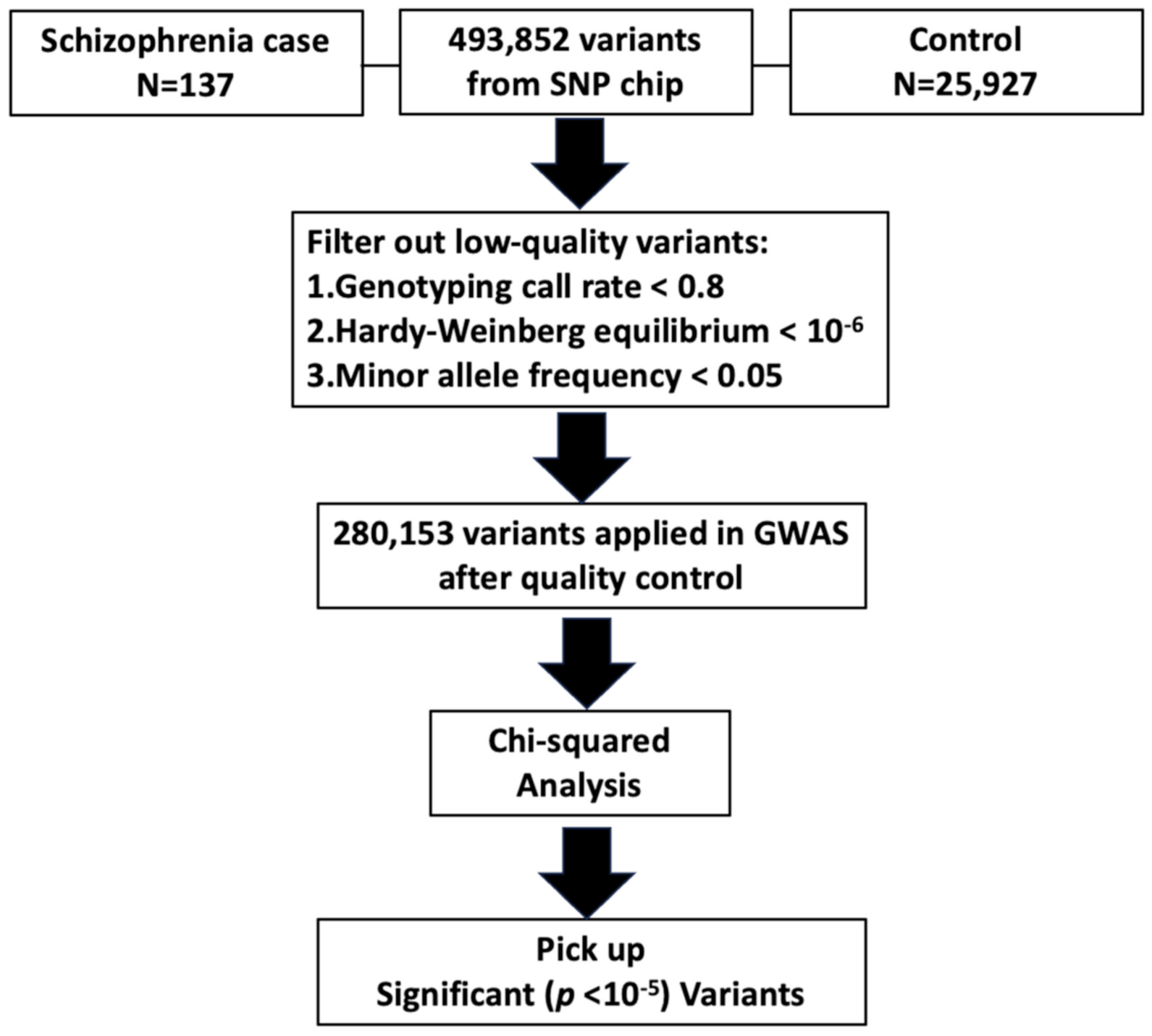
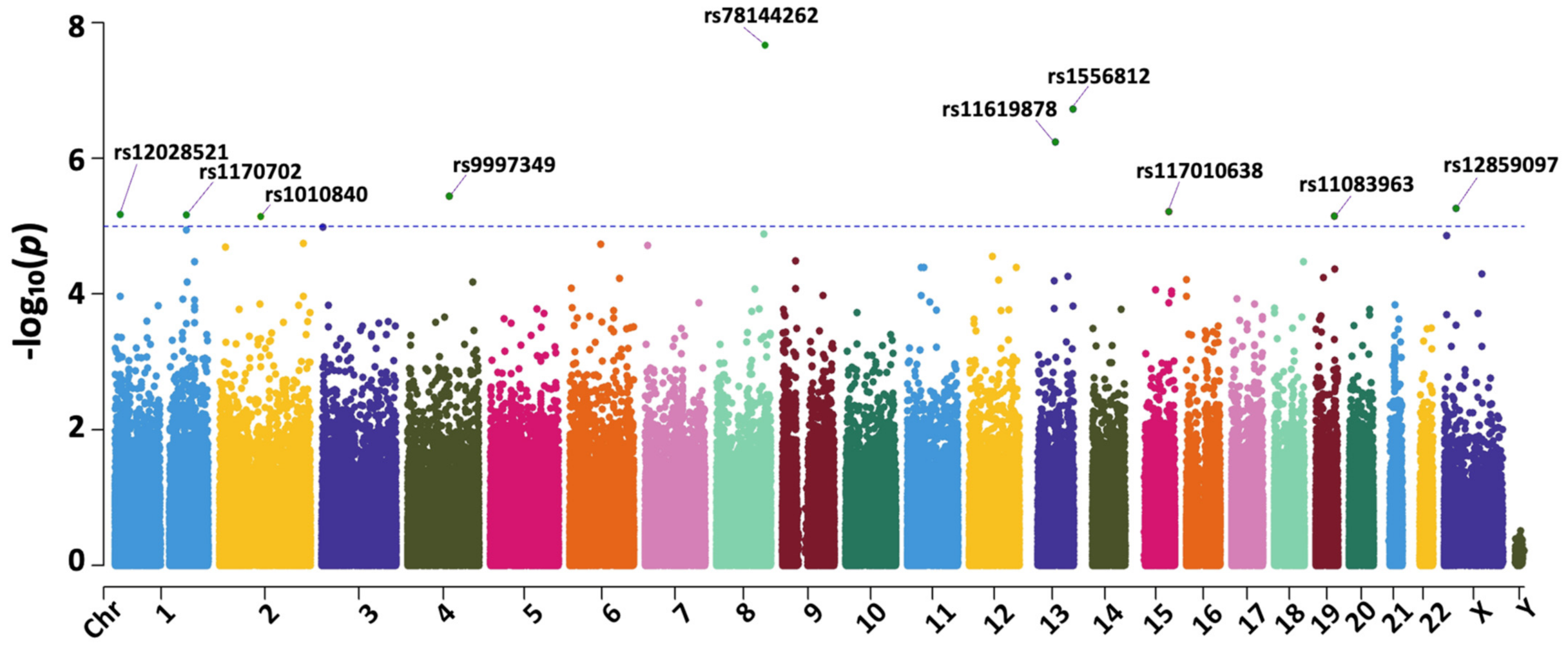
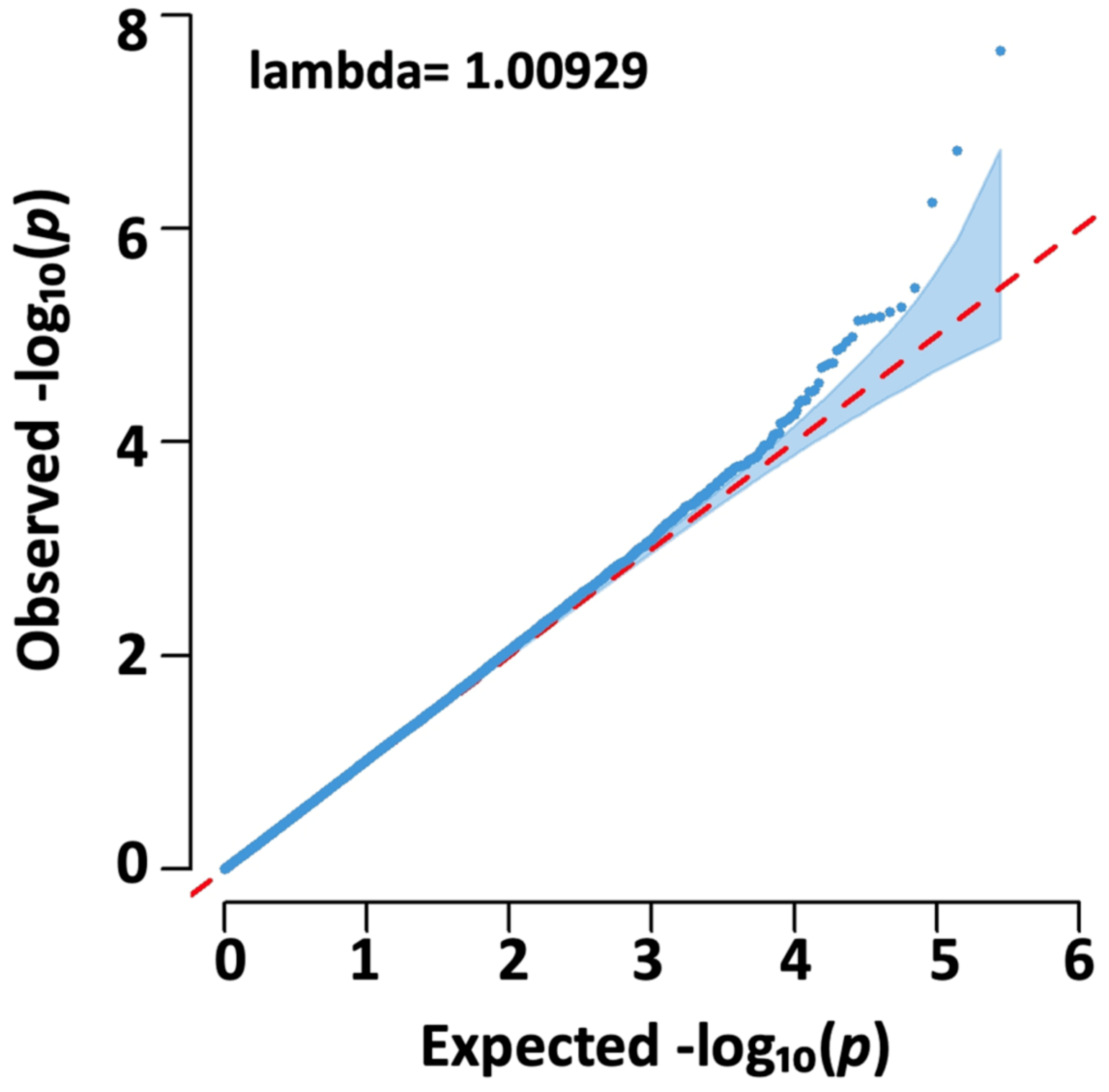
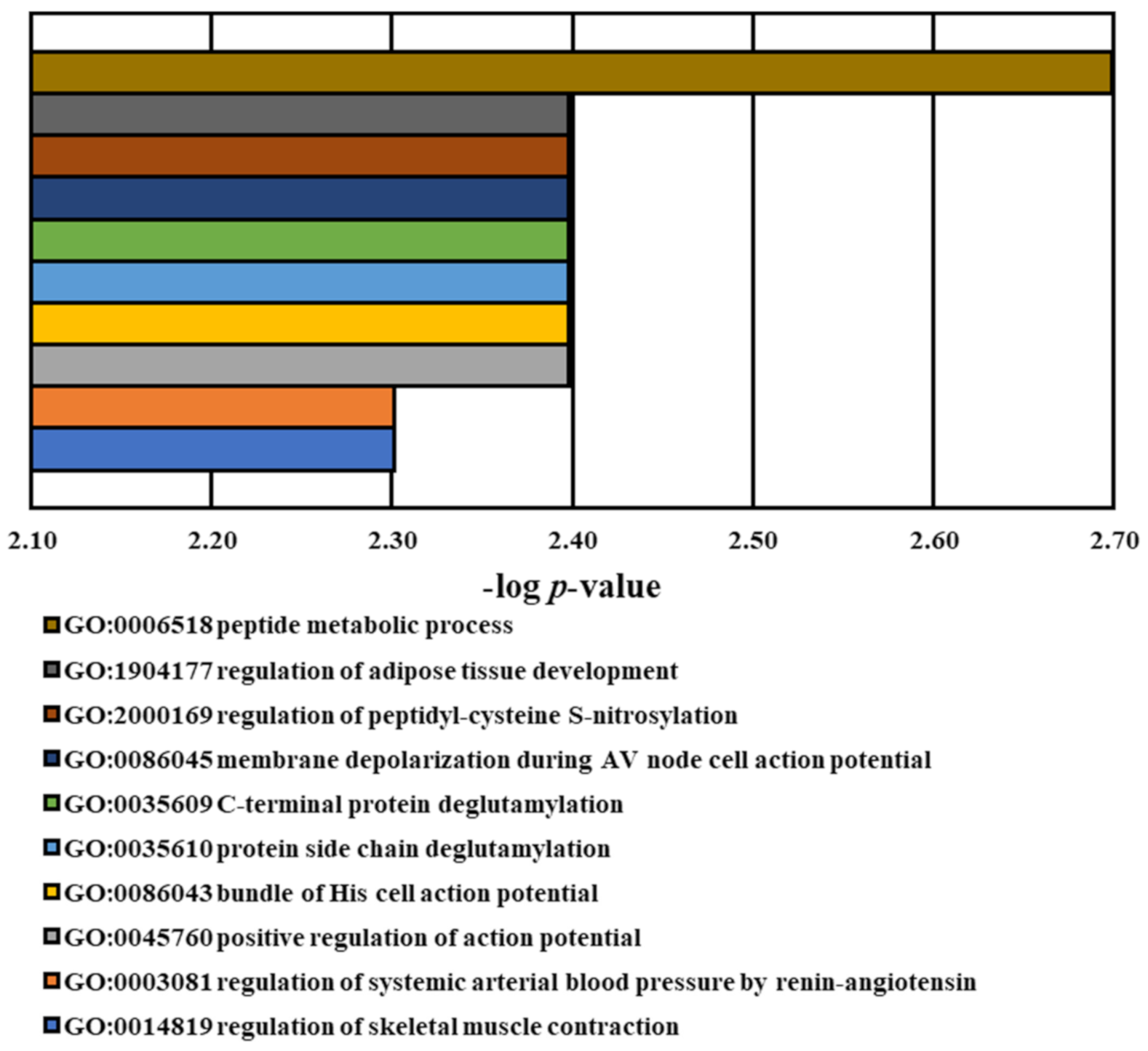
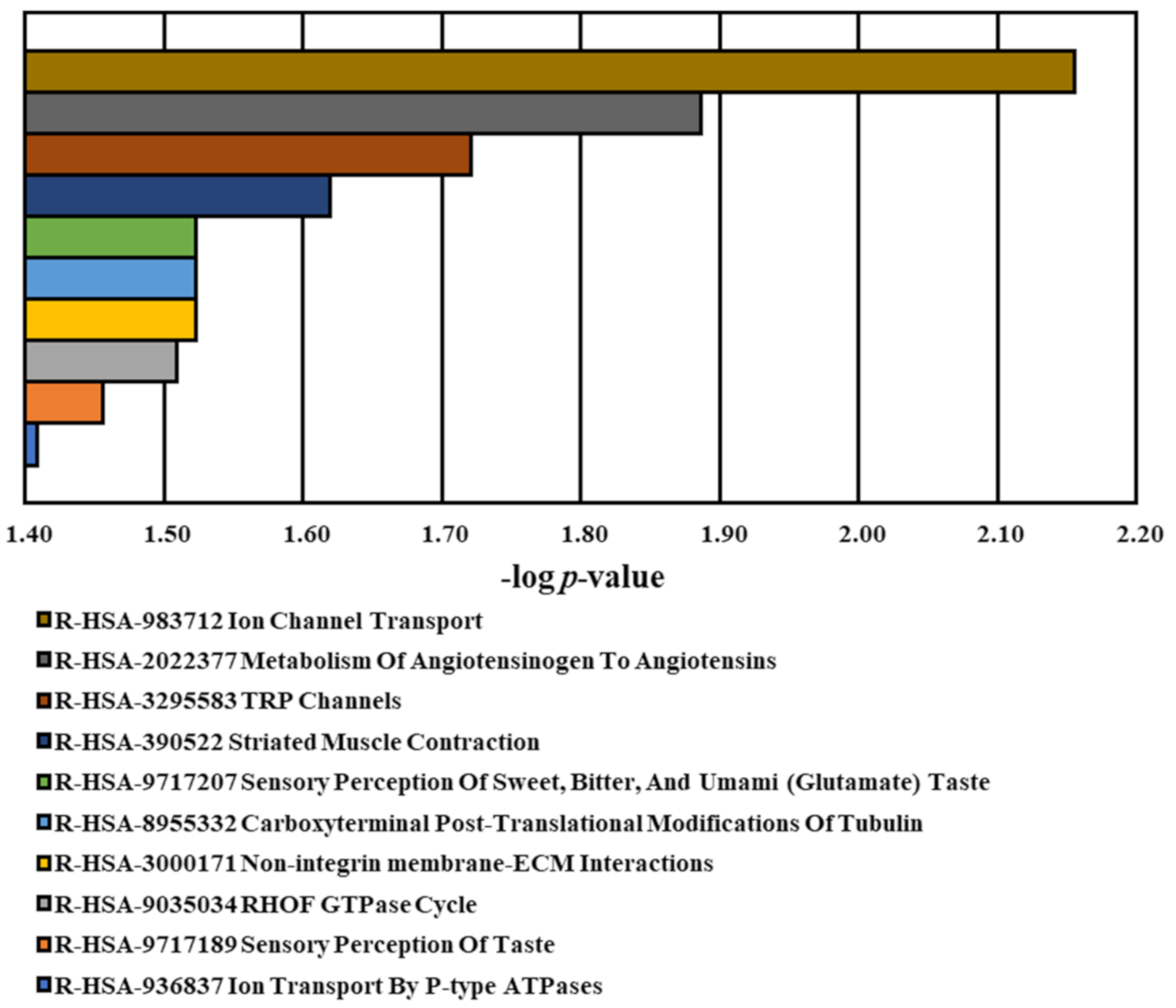
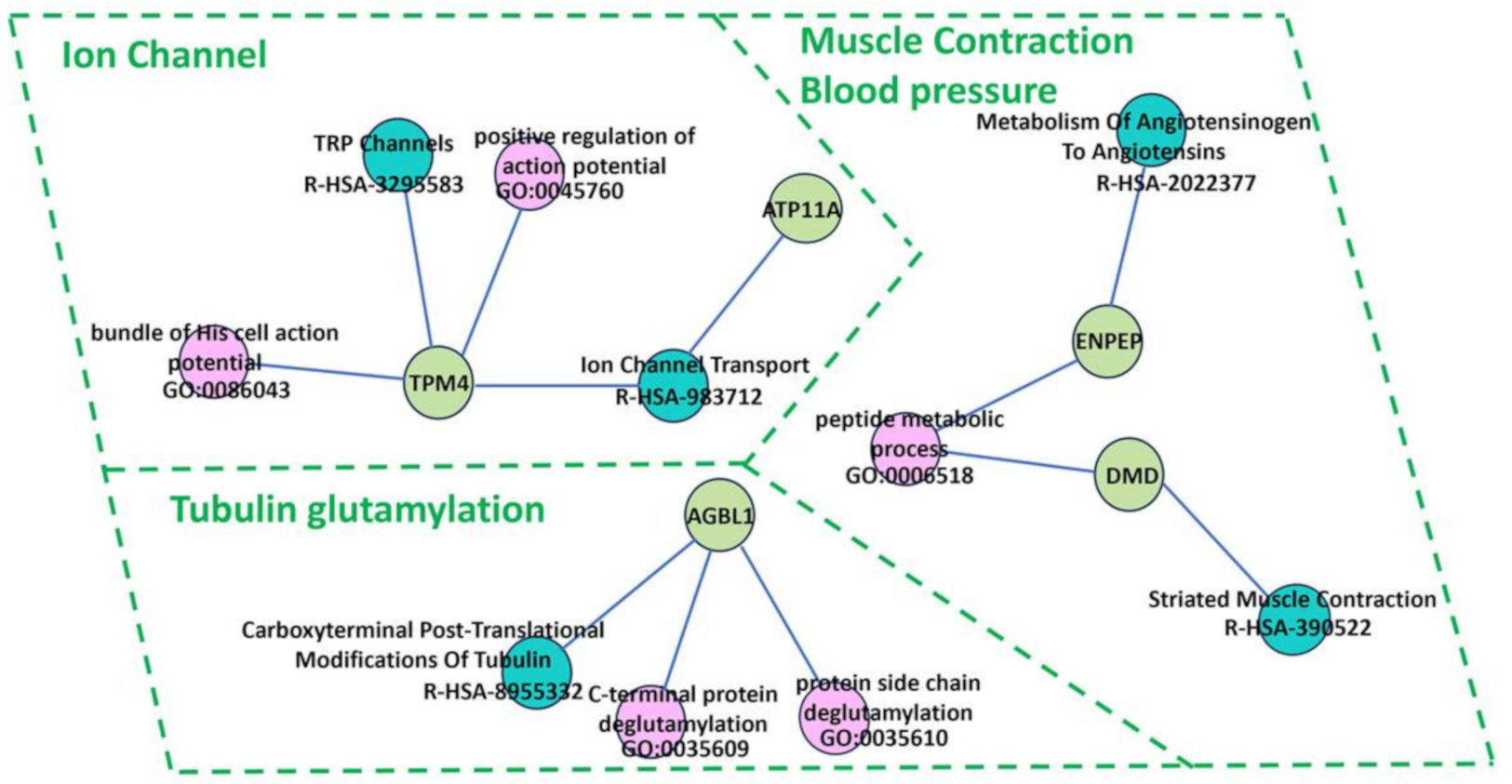
| Group | Schizophrenia a (n = 137) | Control (n = 25,927) | ||
|---|---|---|---|---|
| Sex | ||||
| Male | 63 | (46.0%) | 11,676 | (45.0%) |
| Female | 74 | (54.0%) | 14,251 | (55.0%) |
| Age | ||||
| 80–89 | 1 | (0.73%) | 895 | (3.42%) |
| 70–79 | 5 | (3.65%) | 2970 | (11.36%) |
| 60–69 | 13 | (9.49%) | 5682 | (21.74%) |
| 50–59 | 33 | (24.09%) | 5124 | (19.60%) |
| 40–49 | 40 | (29.20%) | 4096 | (15.67%) |
| 30–39 | 27 | (19.71%) | 3425 | (13.1%) |
| 20–29 | 17 | (12.41%) | 3002 | (11.49%) |
| <20 | 1 | (0.73%) | 733 | (2.81%) |
| CHR | Position | SNP ID | Ref a | Alt b | p-Value c | Odds Ratio ± SD | 95% CI | Effect Size d | Region | Relative Gene |
|---|---|---|---|---|---|---|---|---|---|---|
| 1 | 14175667 | rs12028521 | A | G | 6.72 × 10−6 | 0.53 ± 0.14 | 0.40−0.70 | −0.004 | intergenic | PRDM2; KAZN |
| 1 | 190853292 | rs1170702 | T | C | 6.80 × 10−6 | 2.22 ± 0.18 | 1.55−3.17 | 0.000 | intergenic | LINC01720; LINC01680 |
| 2 | 109675309 | rs1010840 | T | C | 7.20 × 10−6 | 1.74 ± 0.12 | 1.36−2.22 | 0.014 | intergenic | SOWAHC; RGPD6 |
| 4 | 110552210 | rs9997349 | A | G | 3.62 × 10−6 | 2.18 ± 0.17 | 1.55−3.05 | 0.014 | intronic | ENPEP |
| 8 | 129221357 | rs78144262 | G | A | 2.14 × 10−8 | 2.24 ± 0.15 | 1.68−2.99 | 0.026 | ncRNA_intronic | LINC00977 |
| 13 | 65637888 | rs11619878 | G | A | 5.71 × 10−7 | 2.25 ± 0.17 | 1.63−3.13 | 0.018 | intergenic | LINC00355; LINC01052 |
| 13 | 112867397 | rs1556812 | C | G | 1.87 × 10−7 | 2.50 ± 0.18 | 1.75−3.57 | 0.000 | intronic | ATP11A |
| 15 | 85947722 | rs117010638 | A | C | 6.07 × 10−6 | 2.12 ± 0.17 | 1.52−2.96 | 0.001 | intergenic | MIR548AP; AGBL1 |
| 19 | 49162083 | rs11083963 | G | A | 7.11 × 10−6 | 1.72 ± 0.12 | 1.36−2.19 | 0.014 | intronic | TRPM4 |
| X | 31237060 | rs12859097 | G | T | 5.44 × 10−6 | 2.22 ± 0.18 | 1.56−3.16 | 0.016 | intronic | DMD |
| This Study | TPMI a | Twbank b | 1000g c | gnomAD d | ||||||||||
|---|---|---|---|---|---|---|---|---|---|---|---|---|---|---|
| SNP ID | Alt | Case | Control | AFR | AMR | EAS | EUR | AFR | AMR | EAS | FIN | NFE | ||
| rs12028521 | G | 0.234 | 0.365 | 0.365 | 0.371 | 0.200 | 0.310 | 0.350 | 0.110 | 0.174 | 0.258 | 0.361 | 0.114 | 0.109 |
| rs1170702 | C | 0.128 | 0.062 | 0.060 | 0.059 | - | - | - | - | - | - | - | - | - |
| rs1010840 | C | 0.383 | 0.263 | 0.267 | 0.264 | 0.086 | 0.190 | 0.240 | 0.075 | 0.103 | 0.168 | 0.269 | 0.059 | 0.080 |
| rs9997349 | G | 0.146 | 0.073 | 0.072 | 0.073 | - | - | - | - | - | - | - | - | - |
| rs78144262 | A | 0.215 | 0.109 | 0.111 | 0.119 | - | 0.099 | 0.090 | 0.002 | 0.002 | 0.146 | 0.109 | 0.013 | 0.002 |
| rs11619878 | A | 0.157 | 0.076 | 0.078 | 0.076 | 0.430 | 0.410 | 0.086 | 0.500 | 0.443 | 0.384 | 0.082 | 0.501 | 0.518 |
| rs1556812 | G | 0.128 | 0.055 | 0.058 | 0.061 | 0.340 | 0.300 | 0.085 | 0.240 | 0.285 | 0.276 | 0.058 | 0.266 | 0.219 |
| rs117010638 | C | 0.150 | 0.077 | 0.076 | 0.076 | - | - | 0.090 | 0.012 | 0.000 | 0.000 | 0.073 | 0.059 | 0.004 |
| rs11083963 | A | 0.577 | 0.442 | 0.440 | 0.430 | 0.200 | 0.530 | 0.390 | 0.550 | 0.266 | 0.596 | 0.435 | 0.524 | 0.560 |
| rs12859097 | T | 0.180 | 0.090 | 0.092 | 0.094 | - | - | - | - | - | - | - | - | - |
| Variant and Risk Allele | p-Value | RAF | Beta | Reported Trait | Trait(s) | Study Accession |
|---|---|---|---|---|---|---|
| rs11619878-G | 1 × 10−7 | 0.511 | 0.163 unit decrease | IgG glycosylation | Serum IgG glycosylation measurement | GCST001848 |
| GO_ID | Term | p-Value | Gene |
|---|---|---|---|
| GO:0006518 | Peptide metabolic process | 0.002 | ENPEP; DMD |
| GO:0035609 | C-terminal protein deglutamylation | 0.004 | AGBL1 |
| GO:0035610 | Protein side chain deglutamylation | 0.004 | AGBL1 |
| GO:0045760 | Positive regulation of action potential | 0.004 | TRPM4 |
| GO:0086043 | Bundle of His cell action potential | 0.004 | TRPM4 |
| GO:0086045 | Membrane depolarization during AV node cell action potential | 0.004 | TRPM4 |
| GO:1904177 | Regulation of adipose tissue development | 0.004 | TRPM4 |
| GO:2000169 | Regulation of peptidyl-cysteine S-nitrosylation | 0.004 | DMD |
| GO:0003081 | Regulation of systemic arterial blood pressure by renin-angiotensin | 0.005 | ENPEP |
| GO:0014819 | Regulation of skeletal muscle contraction | 0.005 | DMD |
| GO:0086016 | AV node cell action potential | 0.005 | TRPM4 |
| GO:1904181 | Positive regulation of membrane depolarization | 0.005 | TRPM4 |
| GO:0010831 | Positive regulation of myotube differentiation | 0.006 | ATP11A |
| GO:0035608 | Protein deglutamylation | 0.006 | AGBL1 |
| GO:0002709 | Regulation of T cell mediated immunity | 0.008 | TRPM4 |
| GO:0002002 | Regulation of angiotensin levels in blood | 0.009 | ENPEP |
| GO:0002003 | Angiotensin maturation | 0.009 | ENPEP |
| GO:0018410 | C-terminal protein amino acid modification | 0.009 | AGBL1 |
| GO:0098660 | Inorganic ion transmembrane transport | 0.009 | TRPM4 |
| GO:0098911 | Regulation of ventricular cardiac muscle cell action potential | 0.009 | TRPM4 |
| GO:1902307 | Positive regulation of sodium ion transmembrane transport | 0.009 | DMD |
| GO:0030502 | Negative regulation of bone mineralization | 0.010 | TRPM4 |
| GO:0035774 | Positive regulation of insulin secretion involved in cellular responseto glucose stimulus | 0.010 | TRPM4 |
| GO:2000651 | Positive regulation of sodium ion transmembrane transporter activity | 0.010 | DMD |
| GO:0035994 | Response to muscle stretch | 0.011 | DMD |
| GO:0001990 | Regulation of systemic arterial blood pressure by hormone | 0.012 | ENPEP |
| GO:0002407 | Dendritic cell chemotaxis | 0.012 | TRPM4 |
| GO:0045907 | Positive regulation of vasoconstriction | 0.012 | TRPM4 |
| GO:0010460 | Positive regulation of heart rate | 0.013 | TRPM4 |
| GO:0010881 | Regulation of cardiac muscle contraction by regulation of the release ofsequestered calcium ion | 0.013 | DMD |
| GO:0036336 | Dendritic cell migration | 0.013 | TRPM4 |
| GO:0086012 | Membrane depolarization during cardiac muscle cell action potential | 0.013 | TRPM4 |
| GO:0098719 | Sodium ion import across plasma membrane | 0.013 | TRPM4 |
| GO:0002724 | Regulation of T cell cytokine production | 0.014 | TRPM4 |
| GO:0045823 | Positive regulation of heart contraction | 0.015 | TRPM4 |
| GO:0010882 | Regulation of cardiac muscle contraction by calcium ion signaling | 0.016 | DMD |
| GO:0033137 | Negative regulation of peptidyl-serine phosphorylation | 0.016 | DMD |
| GO:0070168 | Negative regulation of biomineral tissue development | 0.016 | TRPM4 |
| GO:1901385 | Regulation of voltage-gated calcium channel activity | 0.016 | DMD |
| GO:0010880 | Regulation of release of sequestered calcium ion into cytosol by sarcoplasmicreticulum | 0.017 | DMD |
| GO:0002718 | Regulation of cytokine production involved in immune response | 0.018 | TRPM4 |
| GO:0030279 | Negative regulation of ossification | 0.018 | TRPM4 |
| GO:0034204 | Lipid translocation | 0.018 | ATP11A |
| GO:0010830 | Regulation of myotube differentiation | 0.019 | ATP11A |
| GO:0032414 | Positive regulation of ion transmembrane transporter activity | 0.019 | DMD |
| GO:0043171 | Peptide catabolic process | 0.019 | ENPEP |
| GO:0060314 | Regulation of ryanodine-sensitive calcium-release channel activity | 0.019 | DMD |
| GO:0098901 | Regulation of cardiac muscle cell action potential | 0.019 | TRPM4 |
| GO:0051155 | Positive regulation of striated muscle cell differentiation | 0.020 | ATP11A |
| GO:0086004 | Regulation of cardiac muscle cell contraction | 0.020 | TRPM4 |
| GO:0061178 | Regulation of insulin secretion involved in cellular response to glucosestimulus | 0.021 | TRPM4 |
| GO:0006942 | Regulation of striated muscle contraction | 0.022 | DMD |
| GO:0019229 | Regulation of vasoconstriction | 0.022 | TRPM4 |
| GO:0035633 | Maintenance of blood-brain barrier | 0.022 | DMD |
| GO:0086001 | Cardiac muscle cell action potential | 0.022 | DMD |
| GO:1901019 | Regulation of calcium ion transmembrane transporter activity | 0.022 | DMD |
| GO:0045332 | Phospholipid translocation | 0.023 | ATP11A |
| GO:0045668 | Negative regulation of osteoblast differentiation | 0.023 | TRPM4 |
| GO:0055001 | Muscle cell development | 0.024 | DMD |
| GO:0060048 | Cardiac muscle contraction | 0.025 | DMD |
| GO:0042692 | Muscle cell differentiation | 0.026 | DMD |
| GO:0030049 | Muscle filament sliding | 0.028 | DMD |
| GO:0032024 | Positive regulation of insulin secretion | 0.028 | TRPM4 |
| GO:0033275 | Actin-myosin filament sliding | 0.028 | DMD |
| GO:0086091 | Regulation of heart rate by cardiac conduction | 0.029 | TRPM4 |
| GO:0060047 | Heart contraction | 0.030 | DMD |
| GO:2000649 | Regulation of sodium ion transmembrane transporter activity | 0.030 | DMD |
| GO:0001508 | Action potential | 0.033 | DMD |
| GO:0098655 | Cation transmembrane transport | 0.033 | TRPM4 |
| GO:0043604 | Amide biosynthetic process | 0.038 | DMD |
| GO:0045600 | Positive regulation of fat cell differentiation | 0.038 | TRPM4 |
| GO:0051279 | Regulation of release of sequestered calcium ion into cytosol | 0.038 | DMD |
| GO:0051289 | Protein homotetramerization | 0.038 | TRPM4 |
| GO:0006941 | Striated muscle contraction | 0.040 | DMD |
| GO:0016925 | Protein sumoylation | 0.040 | TRPM4 |
| GO:0030500 | Regulation of bone mineralization | 0.042 | TRPM4 |
| GO:0007517 | Muscle organ development | 0.043 | DMD |
| GO:0015914 | Phospholipid transport | 0.043 | ATP11A |
| GO:1901565 | Organonitrogen compound catabolic process | 0.046 | ENPEP |
| Reactome ID | Term | p-Value | Gene |
|---|---|---|---|
| R-HSA-983712 | Ion channel transport | 0.007 | ATP11A; TRPM4 |
| R-HSA-2022377 | Metabolism of angiotensinogen to angiotensins | 0.013 | ENPEP |
| R-HSA-3295583 | TRP channels | 0.019 | TRPM4 |
| R-HSA-390522 | Striated muscle contraction | 0.024 | DMD |
| R-HSA-3000171 | Non-integrin membrane–ECM interactions | 0.030 | DMD |
| R-HSA-8955332 | Carboxyterminal post-translational modifications of tubulin | 0.030 | AGBL1 |
| R-HSA-9717207 | Sensory perception of sweet, bitter, and umami (glutamate) taste | 0.030 | TRPM4 |
| R-HSA-9035034 | RHOF GTPase cycle | 0.031 | SOWAHC |
| R-HSA-9717189 | Sensory perception of taste | 0.035 | TRPM4 |
| R-HSA-936837 | Ion transport by P-type ATPases | 0.039 | ATP11A |
Disclaimer/Publisher’s Note: The statements, opinions and data contained in all publications are solely those of the individual author(s) and contributor(s) and not of MDPI and/or the editor(s). MDPI and/or the editor(s) disclaim responsibility for any injury to people or property resulting from any ideas, methods, instructions or products referred to in the content. |
© 2024 by the authors. Licensee MDPI, Basel, Switzerland. This article is an open access article distributed under the terms and conditions of the Creative Commons Attribution (CC BY) license (https://creativecommons.org/licenses/by/4.0/).
Share and Cite
Huang, C.-C.; Wang, Y.-G.; Hsu, C.-L.; Yeh, T.-C.; Chang, W.-C.; Singh, A.B.; Yeh, C.-B.; Hung, Y.-J.; Hung, K.-S.; Chang, H.-A. Identification of Schizophrenia Susceptibility Loci in the Urban Taiwanese Population. Medicina 2024, 60, 1271. https://doi.org/10.3390/medicina60081271
Huang C-C, Wang Y-G, Hsu C-L, Yeh T-C, Chang W-C, Singh AB, Yeh C-B, Hung Y-J, Hung K-S, Chang H-A. Identification of Schizophrenia Susceptibility Loci in the Urban Taiwanese Population. Medicina. 2024; 60(8):1271. https://doi.org/10.3390/medicina60081271
Chicago/Turabian StyleHuang, Chih-Chung, Yi-Guang Wang, Chun-Lun Hsu, Ta-Chuan Yeh, Wei-Chou Chang, Ajeet B. Singh, Chin-Bin Yeh, Yi-Jen Hung, Kuo-Sheng Hung, and Hsin-An Chang. 2024. "Identification of Schizophrenia Susceptibility Loci in the Urban Taiwanese Population" Medicina 60, no. 8: 1271. https://doi.org/10.3390/medicina60081271






